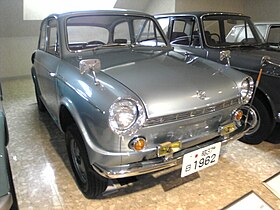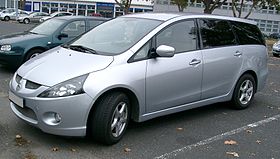Mitsubishi GTO
| Mitsubishi GTO | |
|---|---|
| Overview | |
| Manufacturer | Mitsubishi Motors |
| Also called | Mitsubishi 3000GT |
| Production | 1990–2001 (Mitsubishi GTO) MY1991–1996 (Dodge Stealth) |
| Assembly | Okazaki, Aichi, Japan (Nagoya Plant) |
| Body and chassis | |
| Class | Sports car, grand tourer |
| Body style | 2-door coupe 2-door convertible (1995–1996) |
| Layout | Transverse front-engine, front-/four-wheel drive |
| Platform | Z15AM , Z15A, Z16A |
| Related | Dodge Stealth |
| Powertrain | |
| Engine | 6G72 3.0 L V6 • SOHC 12v • DOHC 24v • DOHC 24v twin-turbo |
| Transmission | 4-speed automatic 5-speed manual 6-speed manual (from 1994) |
| Dimensions | |
| Wheelbase | 2,470 mm (97.2 in) |
| Length | 4,600 mm (181.1 in) |
| Width | 1,840 mm (72.4 in) |
| Height | 1,285 mm (50.6 in) |
| Curb weight | 1,400–1,710 kilograms (3,090–3,770 lb) |
| Chronology | |
| Predecessor | Mitsubishi Starion (wide body) |
The Mitsubishi GTO is a sports car built by Japanese automaker Mitsubishi between 1990 and 2001. In most export markets it was rebadged as a Mitsubishi 3000GT. It was also imported and sold by Chrysler in North America as aDodge Stealth captive import from the 1991 to 1996 model years with only minor detail/appearance differences; mechanically, the two cars were identical. The Mitsubishi GTO, or Mitsubishi 3000GT, and Dodge Stealth design was the result of the collaborative effort between Chrysler and its Japanese partner, Mitsubishi Motors. The Japanese model took its name from the Galant GTO, a two-door hardtop coupé sold by the company in the early 1970s, which in turn got its name from the Ferrari GTO, which means Gran Turismo Omologato (homologation). In Japan, it was sold at a specific retail chain called Car Plaza.
Overview
Following the successful showing of the Mitsubishi HSR and Mitsubishi HSX concept cars at the 1989 Tokyo Motor Show,[1] Mitsubishi developed the new GTO as a technologically advanced 2+2 seater sports coupe to compete with theHonda NSX, Mazda Cosmo, Nissan 300ZX, Skyline GT-R, Subaru SVX and the Toyota Supra. They resurrected the GTOname, and the car went on to serve as Mitsubishi’s flagship for the remainder of the decade. However, despite the cachet of the badge at home, it was marketed as the Mitsubishi 3000GT and as the Dodge Stealth outside Japan; the company was concerned that connoisseurs would object to the evocative nameplate from the highly regarded Ferrari 250 GTO and Pontiac GTO being used on a Japanese vehicle. However, regardless of its badge or eventual target market, every car was built on the same production line at Mitsubishi's plant in Nagoya, Japan.[2] Its introduction in Japan was during the softening of the Japanese economy, known as the "bubble economy" which had an effect on sales.
A Dodge Stealth (an American export of the GTO) was initially to be used as a pace car for the 1991 Indianapolis 500race. The United Auto Workers (UAW), however, rejected the Japanese-manufactured car, as they deferred the concept of a Mitsubishi being a pace car for the race, and a prototype Dodge Viper was substituted.[3]
1990–1993 Z16A
The first generation model incorporated many of Mitsubishi's contemporary performance-enhancing technologies, such as full-time four-wheel drive, four-wheel steering, active aerodynamics featuring automatically adjusting front and rear spoilers, sport/tour exhaust modes and electronically controlled suspension (ECS).[4]These "Active Aerodynamics" were not used on the Dodge Stealth. Visually, both the GTO, 3000GT and Stealth featured pop-up headlights and noticeable "caps" on the hood to accommodate the ECS controllers at the top of the strut turrets. However the rest of factory body kit differed in styling with their respective badges. Most notable are the Dodge signature cross-hairs on the Stealth front bumper fascia, Ferrari inspired gills on the 3000GT rocker panels, Crescent shaped spoiler on the Stealth commonly referred to as the "Banana Wing" and front Active Aero air dam on 3000GT VR4 (later discontinued on newer models).
| Model name | Engine | Peak power | Peak torque |
|---|---|---|---|
| Dodge Stealth (United States, Canada) | SOHC 12v V6 | 119 kW (162 PS; 160 hp) at 5500 rpm | 250 N·m (184 lb·ft) at 4000 rpm |
| Mitsubishi 3000GT, 3000GT SL (United States); Mitsubishi GTO;Dodge Stealth ES, Stealth R/T (United States, Canada) | DOHC 24v V6 | 164 kW (223 PS; 220 hp) at 6000 rpm | 272 N·m (201 lb·ft) at 4500 rpm |
| Mitsubishi GTO twin turbo, GTO MR | DOHC 24v V6 twin turbo | 206 kW (280 PS; 276 hp) at 6000 rpm | 427 N·m (315 lb·ft) at 2500 rpm |
| Mitsubishi 3000GT VR-4, 3000GT (Europe), Dodge Stealth R/T twin-turbo (United States, Canada) | DOHC 24v V6 twin turbo | 221 kW (300 PS; 296 hp) at 6000 rpm | 415 N·m (306 lb·ft) at 2500 rpm |
1994–1997 Z15A
Second generation models are identified by a revised front bumper to accommodate projector beam headlights and small, round projector fog lights. The caps on the hood were replaced with integrated blisters, and the side air vents and rear bumpers were modified. The interior was redesigned with dual air bags, a new audio system, and revised air conditioning refrigerant. The engines in the twin-turbo models received a slight boost in torque from 307 lb·ft (416 N·m) to 315 lb·ft (427 N·m). To complement this, the VR-4 now included a six-speed Getrag manual transmission. Bigger wheel/tire combinations were provided beginning in 1995. The base and SL model received 16" wheels in silver or chrome with 225/55 tires, while the VR4 now had 18" chrome wheels with 245/40 tires (the Spyder had the standard 17" with higher profile tires from 1994 to handle the additional 400 lb (180 kg)).
As the price of the cars increased, many of the "gadgets" on the car were discontinued. The tunable exhaust was phased out after model year 1994, the ECS disappeared after the 1995 model year, and the active aerodynamics disappeared after 1996. Finally, Chrysler ceased sales of the Dodge Stealth captive import, and for the remainder of its life only Mitsubishi-badged versions were available.
Mitsubishi had produced a number of limited edition 3000GT VR4 convertibles. The rare special edition was known as the Spyder VR4. Only 877 were imported to America. When the Spyder was released, it never reached the European and Japanese market. The United States had their own version of the VR4. These cars were modified to be convertibles in the United States by ASC Corporation. The U.S and the Mitsubishi factories worked with another company to convert the 3000GTs into a hard-top convertible.The Spyder was one of very few hard-tops to release in the United States. The Spyder had released in 1995 and ended production in 1996. In 1995 Mitsubishi's 3000GT Spyder was available in 4 different combinations: carson red w/ grey leather interior, sable black w/ ivory leather interior, glacier white pearl w/ grey, and martinique yellow pearl w/ ivory leather interior. In 1996 the 3000GT Spyder was available in four different options: caracas red w/tan interior, solano black pearl w/ tan leather, glacier white pearl w/ tan leather interior, and pamana green pearl w/ tan leather. Its many unique color options, and hard-top convertible gave the vehicle a unique history, and created a cosmetic impact in the auto industry. While the cosmetics of the Spyder VR4 made it unique, its framework differed. The Spyder’s frame and bodywork was similar to their brothers, the 3000GT SL and VR4 models. The Spyder model had its disadvantages over the VR4 and SL, due to heavy brackets under the body. The extra weight under the body interfered with the handling. Due to slow sales of these vehicles, Mitsubishi decided to discontinue the 3000GT VR4 Spyder.
| Model name | Engine | Peak power | Peak torque |
|---|---|---|---|
| Dodge Stealth (United States, Canada) | SOHC 12v V6 | 119 kW (162 PS; 160 hp) at 5500 rpm | 250 N·m (184 lb·ft) at 4000 rpm |
| Mitsubishi 3000GT, 3000GT SL, 3000GT SL Spyder (United States);Mitsubishi GTO; Stealth R/T (United States, Canada) | DOHC 24v V6 | 222 hp (166 kW; 225 PS) at 6000 rpm | 277 N·m (204 lb·ft) at 4500 rpm |
| Mitsubishi GTO twin turbo, GTO MR | DOHC 24v V6 twin turbo | 206 kW (280 PS; 276 hp) at 6000 rpm | 427 N·m (315 lb·ft) at 2500 rpm |
| Mitsubishi 3000GT VR-4, 3000GT VR-4 Spyder, 3000GT(Europe);Dodge Stealth R/T twin-turbo (United States, Canada) | DOHC 24v V6 twin turbo | 238.4 kW (324 PS; 320 hp) at 6000 rpm | 427 N·m (315 lb·ft) at 2500 rpm |
1998–2001 Z15AM
The SOHC engine, previously only available in the base model Stealth, was added to the Mitsubishi range after the Dodge version was discontinued. Slower sales in the American sports car market led to a planned facelift for 1997 being abandoned in favor of minor cosmetic adjustments, including a new front bumper and rainbow shaped arched type wing. In 1999 the car received another exterior makeover, including a new aggressive front bumper, headlamps, turn signals, sail panels, and a true inverted airfoil spoiler coined the "Combat Wing" for the 1999 VR-4 to distinguish it from previous models. 1999 was the final year the 3000GT was available in the U.S. market. Production for the Japanese domestic market finally ceased in 2000, with the last two cars sold the following year.[5]
| Model name | Engine | Peak power | Peak torque |
|---|---|---|---|
| Mitsubishi 3000GT (United States) | SOHC 12v V6 | 119 kW (162 PS; 160 hp) at 5500 rpm | 250 N·m (184 lb·ft) at 4000 rpm |
| Mitsubishi 3000GT SL (United States); Mitsubishi GTO SR(Japan) | DOHC 24v V6 | 218 hp (163 kW; 221 PS) at 6000 rpm | 277 N·m (204 lb·ft) at 4500 rpm |
| Mitsubishi GTO twin turbo, Mitsubishi GTO twin turbo MR | DOHC 24v V6 twin turbo | 206 kW (280 PS; 276 hp) at 6000 rpm | 427 N·m (315 lb·ft) at 2500 rpm |
| Mitsubishi 3000GT VR-4 | DOHC 24v V6 twin turbo | 238.4 kW (324 PS; 320 hp) at 6000 rpm | 427 N·m (315 lb·ft) at 2500 rpm |









